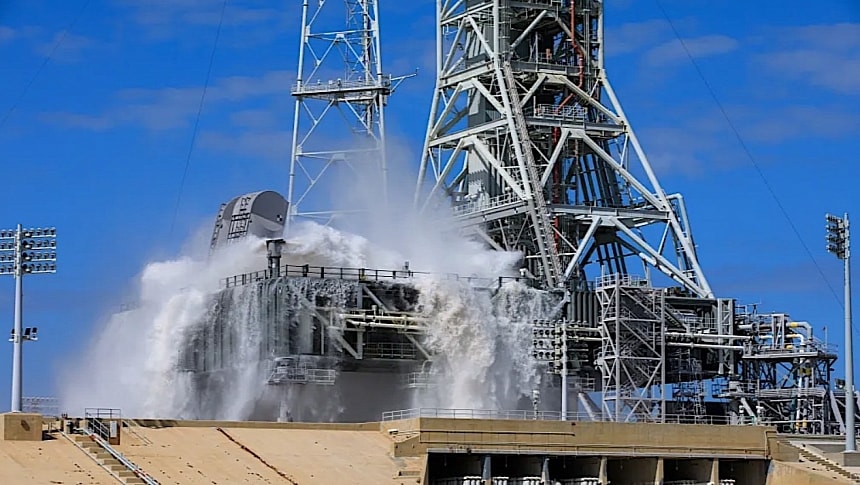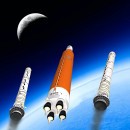Those of you who had the chance to witness a space launch from NASA's Pad 39B at the Kennedy Space Center in Florida might have been surprised by how quiet launches are. Ok, not quiet-quiet, as such events are still disturbingly loud, but a lot quieter than one would expect during the launch of a rocket the size of the Space Launch System.
In full Moon mode, meaning with the four RS-25 engines of the core stage and the two solid boosters burning hot, the rocket is capable of pushing the Orion capsule up with the power of 8.8 million pounds of thrust. Most of that is spent in under eight intense minutes, making a Moon rocket launch a very hot and loud event.
One of the reasons why people don't get to experience all of that at full power is something called the suppression system. Designed first and foremost to protect the launch pad's main components (stuff like the mobile launcher umbilicals and ground systems) from the violence of the launch, it basically relies on water, a lot of it, being released at just the right time.
This is how rocket launches have been performed for decades, but that doesn't mean NASA isn't practicing as hard as it can. The tests for the Artemis II ignition overpressure protection, sound suppression, and launch cooling systems have just been completed at Kennedy.
During the tests NASA let loose no less than 400,000 gallons (1.5 million liters) of water. Stored in large tanks installed at the pad, the water was dumped as fast as possible on the mobile launcher and the flame deflector in a full-scale rehearsal of what we're expecting to see next year, when Artemis II is scheduled to depart.
The tests were needed because some changes were made to the suppression system, believe it or not, fueled by the need to ensure better launch imagery for the historic mission.
First up, there are new water balancing plates, redesigned nozzles, and improved piping that should allow higher water flow rates. Then, the cameras will now sit higher in their housings, protected from all that water by additional splash shields.
The Artemis II Moon mission will be the first of the new space exploration program that will carry a crew. Four people (Reid Wiseman, Victor Glover, Christina Hammock Koch, and Jeremy Hansen) will climb inside the Orion spacecraft to be sent on a trip around the Moon, with no landing.
Even if this group will not be the one to touch down on the Moon, it will still make history. These people will become the humans to have traveled farthest from our world, going 6,400 miles (10,300 km) beyond the Moon before heading back home.
One of the reasons why people don't get to experience all of that at full power is something called the suppression system. Designed first and foremost to protect the launch pad's main components (stuff like the mobile launcher umbilicals and ground systems) from the violence of the launch, it basically relies on water, a lot of it, being released at just the right time.
This is how rocket launches have been performed for decades, but that doesn't mean NASA isn't practicing as hard as it can. The tests for the Artemis II ignition overpressure protection, sound suppression, and launch cooling systems have just been completed at Kennedy.
During the tests NASA let loose no less than 400,000 gallons (1.5 million liters) of water. Stored in large tanks installed at the pad, the water was dumped as fast as possible on the mobile launcher and the flame deflector in a full-scale rehearsal of what we're expecting to see next year, when Artemis II is scheduled to depart.
The tests were needed because some changes were made to the suppression system, believe it or not, fueled by the need to ensure better launch imagery for the historic mission.
First up, there are new water balancing plates, redesigned nozzles, and improved piping that should allow higher water flow rates. Then, the cameras will now sit higher in their housings, protected from all that water by additional splash shields.
The Artemis II Moon mission will be the first of the new space exploration program that will carry a crew. Four people (Reid Wiseman, Victor Glover, Christina Hammock Koch, and Jeremy Hansen) will climb inside the Orion spacecraft to be sent on a trip around the Moon, with no landing.
Even if this group will not be the one to touch down on the Moon, it will still make history. These people will become the humans to have traveled farthest from our world, going 6,400 miles (10,300 km) beyond the Moon before heading back home.


























